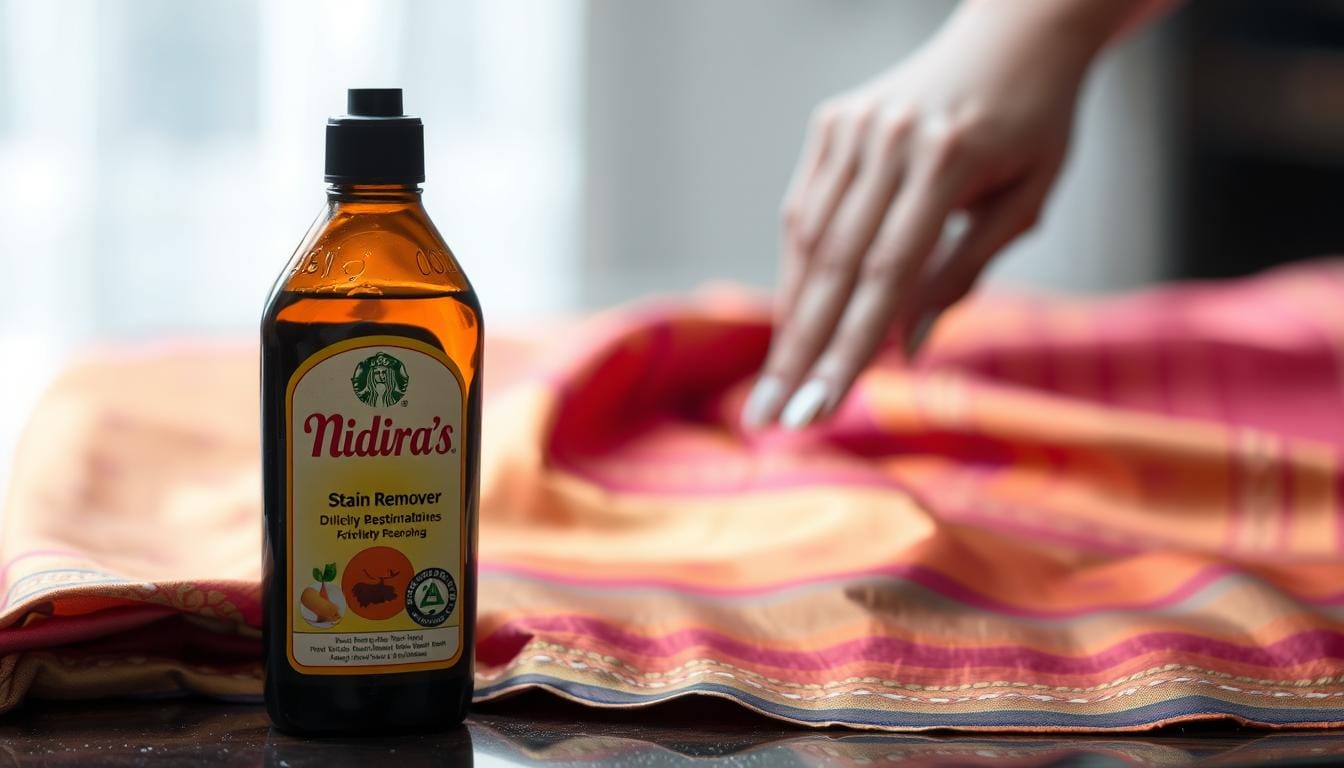Saree Care: How to Store, Wash & Preserve Silk Sarees
Caring for your silk sarees is key to keeping them looking great. With the right steps, you can enjoy your favorite sarees for many years.
Looking to store your silk sarees safely, wash them without harm, or keep their colors bright? This guide is here to assist. Proper saree storage and care can greatly help preserve your sarees’ delicate texture and color.

Key Takeaways
- Learn the best practices for storing your silk sarees.
- Understand how to wash silk sarees without causing damage.
- Discover techniques for preserving the color and texture of your sarees.
- Get tips on handling sarees to prevent wear and tear.
- Find out how to maintain the beauty of your silk sarees over time.
The Cultural and Material Value of Silk Sarees
Silk sarees are more than clothes; they show India’s rich culture and skill. These beautiful items have been a big part of Indian life for ages. They are often kept in families for years, loved by all.
The value of silk sarees is huge, not just because they look great. They are also important for special events like weddings and festivals. They stand for wealth, luck, and happiness in marriage.
Understanding Different Types of Silk Sarees
India is famous for its many silk sarees, each with its own special features. Banarasi sarees are known for their detailed designs and rich fabrics. They often have gold and silver threads.
Kanjeevaram sarees come from Tamil Nadu and are loved for their bright colors and patterns. Patola sarees from Gujarat are prized for their complex weaving and colors.
Knowing about these silk sarees helps us take care of them right. Each one needs special care to keep its beauty and last long.
Why Proper Care Matters for Longevity
Looking after silk sarees is key to keeping them beautiful and lasting. If we don’t store, wash, and handle them right, they can get damaged. The right care keeps them looking great for many years.
It’s not just about cleaning them; it’s about how we store and handle them too. Using the right products and gentle care keeps them safe. This way, we keep their cultural and material value alive.
Essential Supplies for Silk Saree Maintenance
Having the right materials and tools is key for silk saree care. It’s important to know what you need for storage and cleaning. This ensures your sarees last longer.
Storage Materials and Tools
Choosing the right materials for storage is crucial. Acid-free tissue papers and cotton cloths are best because they’re soft on the fabric. They prevent damage.
Use a breathable storage box or cloth bag to keep sarees dust-free. Also, wrap sarees in muslin cloth before storing. This adds extra protection.
Natural vs. Chemical Cleaning Products
Choosing between natural and chemical cleaning products matters. Natural cleaning agents like mild soap or silk wash are safer. They’re gentler on the fabric.
Chemical products can be harsh and damage the saree. They might also cause colors to fade. Natural or eco-friendly products help keep your sarees looking good for longer.
By picking the right storage and cleaning supplies, you can make your silk sarees last longer. They’ll stay vibrant and beautiful for years.
Proper Storage Techniques for Silk Sarees
To keep your silk sarees looking great, it’s key to store them right. Silk sarees are delicate and need special care. Wrong storage can harm their beauty and shorten their life.
Folding vs. Hanging: Which Method Is Best?
The debate on folding vs. hanging silk sarees is ongoing. Folding is often advised to avoid stretching. But, folding must be done right to avoid creases. Hanging is better for sarees with heavy embroidery or prone to creases. Use a padded hanger to support the saree’s weight.
Using Muslin Cloth and Acid-Free Paper
Wrapping your silk sarees in muslin cloth or acid-free paper protects them from dust and moisture. Muslin cloth lets air in, preventing moisture buildup. Acid-free paper stops chemical damage to silk fibers.
| Storage Material | Benefits | Precautions |
| Muslin Cloth | Allows airflow, prevents moisture buildup | Ensure the cloth is clean and dry |
| Acid-Free Paper | Prevents chemical reactions, protects silk fibers | Avoid using paper with any acidic content |
Optimal Storage Conditions and Environment
The right storage environment is crucial for silk sarees. Store them in a cool, dry place away from sunlight. Sunlight can cause fading and discoloration. Keep the temperature and humidity steady to protect the silk.
By using these storage tips, your silk sarees will stay beautiful for many years.
How to Preserve Silk Sarees for Generations
Preserving silk sarees is an art that combines traditional Indian methods with modern techniques. These sarees are precious family treasures. Their longevity depends on proper care.
Traditional Indian Methods of Saree Preservation
For generations, Indians have used certain ways to keep sarees safe. They wrap sarees in cotton or muslin to shield them from dust and moisture.
“The way we store our sarees is a reflection of our respect for tradition and heritage.”
Unknown
Another old practice is storing sarees with natural materials like sandalwood or cedar. These materials are thought to keep insects away and protect the fabric.
Modern Preservation Techniques
Modern methods also play a big role in keeping silk sarees looking good for a long time. Wrapping sarees in acid-free tissue paper is a good idea. It stops the fabric from getting damaged by acidic reactions.
Storing sarees in a climate-controlled area is another modern trick. It keeps the sarees in the best conditions, away from extreme heat and humidity.
Rotation System for Long-Term Care
Using a rotation system is key for taking care of silk sarees over time. This means taking out sarees now and then, checking them, and airing them out to stop them from getting musty.
| Rotation Frequency | Benefits |
| Every 6 months | Prevents mustiness, allows inspection for damage |
| Every 12 months | Ensures sarees are not stored for too long without being aired |
By regularly switching out your sarees, you can wear them and also keep them safe for your family’s future.
Buy Now: Mustard Yellow Kanjeevaram Silk Saree with Zari Border
Step-by-Step Guide to Hand Washing Silk Sarees
To keep your silk sarees looking great, learning to hand wash them is key. Hand washing is a soft way to clean silk sarees without harming the fabric.
Pre-Wash Preparations
Before washing your silk saree, prepare it well. Look for stains or spots and gently remove loose dirt with a soft brush. If your saree has special embroidery, it’s best to get a professional cleaner to avoid damage.
Always test a small, hidden area of the saree with the cleaning solution first. This ensures it won’t harm the fabric or change its color.
Gentle Washing Techniques
Use lukewarm water and a mild detergent made for silk. Soak the saree in the water for about 15 minutes. Don’t wring or rub the saree, as it can damage the silk.
Swish the saree gently in the water, then soak it again if needed. Keep washing until it’s clean. Handle the saree carefully to avoid snags.
Rinsing and Drying Methods
Rinse the saree with lukewarm water to get rid of soap. It’s important to remove all detergent to keep the fabric’s quality and color.
Don’t wring the saree to remove water. Lay it flat on a clean towel, away from sunlight. Roll the towel up to soak up more water. Then, unroll and reshape the saree. Let it air dry, keeping it flat to avoid creases.
When to Avoid Washing
If your silk saree is very dirty or has tough stains, don’t wash it at home. Instead, take it to a professional cleaner who knows how to handle delicate fabrics.
Dealing with Stains and Damages
Stains and damages are common for silk sarees. Knowing how to handle them can make your saree last longer. Whether it’s a spill, a tear, or a snag, acting fast is key to keeping your saree looking great.
Common Stain Removal Techniques for Silk
When cleaning silk, be gentle. For oil-based stains, use talcum powder or cornstarch to soak up the oil. Then, brush off the powder and dampen the area with cold water.
For protein-based stains like blood, a mild detergent solution works well. Always test any cleaning solution on an inconspicuous area first to avoid damage.
White vinegar and water is great for dye or ink stains. But, act fast, as stains get harder to remove over time.
Addressing Minor Damages and Tears
Minor damages and tears can be fixed at home. For small tears, use a needle and thread that matches the saree’s color. Use a fine needle and sew in the direction of the weave to avoid more damage.
For snags, use a crochet hook or snag repair tool to pull the snagged thread back. This makes the snag less visible.
When to Seek Professional Help
While you can fix some damages at home, sometimes you need a pro. If the damage is big, like a large tear or stain, or if you’re not sure what to do, get help. Professional cleaners and repair services can fix your silk saree like new.
Learning how to handle stains and damages helps your silk sarees last longer. This way, you can enjoy them for many years, keeping them beautiful.
Ironing and Pressing Techniques for Silk Sarees
Keeping silk sarees beautiful is more than just storing them. It also means ironing them right. Ironing silk sarees needs care and the right tools to avoid harming the delicate fabric.
Temperature Settings and Equipment
Choosing the right temperature is key when ironing silk sarees. The best temperature is between 300°F to 350°F. Also, use a pressing cloth, like cotton, to protect the silk from scorching.
Key Equipment:
- A steam iron with a temperature control
- A pressing cloth (cotton or muslin)
- An ironing board with a padded cover
Step-by-Step Ironing Process
To iron a silk saree well, follow these steps:
- Make sure the saree is a bit damp. This helps get rid of wrinkles better.
- Put the saree on the ironing board and smooth out big wrinkles by hand.
- Cover the saree with a pressing cloth.
- Iron the saree gently, starting from the top and moving down.
- For designs or embroidery, iron carefully or use a lower heat.
| Ironing Technique | Description | Benefit |
| Gentle Gliding | Move the iron smoothly over the fabric. | Prevents fabric damage |
| Using Steam | Apply steam to relax fibers. | Effective wrinkle removal |
| Lower Temperature for Embellishments | Reduce heat for intricate designs. | Protects delicate areas |
Alternatives to Traditional Ironing
If you don’t want to iron your silk sarees, there are other options. Using a fabric steamer can remove wrinkles without heat. Hanging the saree in a steamy bathroom also works.
By using these ironing and pressing methods, you can keep your silk sarees looking great. This way, they stay beautiful for many years.
Seasonal Care for Your Silk Saree Collection
To keep your silk sarees looking great all year, you need to change how you care for them with the seasons. The humidity of the monsoon and the dryness of winter are big challenges. They can affect how long your silk sarees last and how they look.
Monsoon Care Tips
High humidity in the monsoon can make silk sarees damp. This can lead to mold or mildew. To avoid this, make sure your sarees have good air flow. Use desiccants or silica gel packets to soak up extra moisture. Always check your sarees for dampness.
Summer Storage Solutions
In summer, keep your silk sarees in a cool, dry spot. Avoid direct sunlight, which can fade them. Use breathable storage bags or cloth to cover them. Store them in a room with a steady temperature to protect them from heat.
Winter Protection Measures
In winter, silk sarees need protection from dry air. This can make the fabric brittle. Use a humidifier in your storage area to keep humidity balanced. Also, wrap your sarees in acid-free tissue paper for extra protection.
| Season | Care Tips |
| Monsoon | Use desiccants, ensure good air circulation |
| Summer | Store in cool, dry place, use breathable bags |
| Winter | Use humidifier, wrap in acid-free tissue paper |
Conclusion: Ensuring the Longevity of Your Silk Saree Heritage
Proper care is key to keeping silk sarees beautiful for a long time. By following the tips in this article, your silk saree collection will stay vibrant and intact for years. This way, you can pass it down to future generations.
Preserving silk sarees means paying attention to every detail. You need to use the right materials for storage, wash them gently, and use proper preservation methods. A silk saree care summary shows how important it is to handle them with care, avoid harsh chemicals, and keep them in a cool, dry place.
To make your silk sarees last longer, adopt a few simple habits. Check your sarees often for any damage and fix it right away. Also, consider rotating your sarees so each one gets worn and cared for equally.
By taking the time to care for your silk sarees, you can enjoy them for many years. This not only keeps them beautiful but also preserves their heritage. Whether you’re a seasoned collector or just starting, the tips in this article will help you keep your silk sarees in top condition.
FAQ
How do I store my silk sarees to prevent damage?
To keep your silk sarees safe, use acid-free tissue papers and cotton cloths. Stay away from direct sunlight and moisture. You can fold or hang them, but use a breathable bag or cloth to avoid dust.
Can I wash my silk saree at home?
Yes, you can wash your silk saree at home. Just be gentle. Use mild soap or a silk detergent. Don’t wring or twist it. Rinse in cold water and dry it away from sunlight.
How often should I clean my silk sarees?
How often you clean your silk sarees depends on how often you wear them. If you wear them a lot, clean them every few months. For less frequent wear, clean once a year.
What is the best way to remove stains from silk sarees?
For stains, use mild soap or a silk stain remover. Gently apply the solution and blot with a clean cloth. Avoid rubbing or harsh chemicals to protect the silk.
Can I iron my silk sarees?
Yes, you can iron your silk sarees. Use a low-temperature setting and a pressing cloth to prevent damage. Iron while still damp and avoid too much pressure.
How do I preserve my silk sarees for future generations?
To preserve your silk sarees, store them in a cool, dry place away from sunlight. Use acid-free materials and avoid excessive folding or creasing. Consider rotating them to prevent long-term storage without airing or wearing.
What are the best storage conditions for silk sarees during different seasons?
In the monsoon, store your silk sarees in a dry, well-ventilated area to prevent moisture damage. In summer, use breathable bags or cloths to keep them cool. In winter, store them in a cool, dry place, away from sunlight.
When should I seek professional help for my silk sarees?
If your silk saree has a stubborn stain, is damaged, or needs intricate repair, seek professional help. A reputable dry cleaner or saree restoration expert can help.



